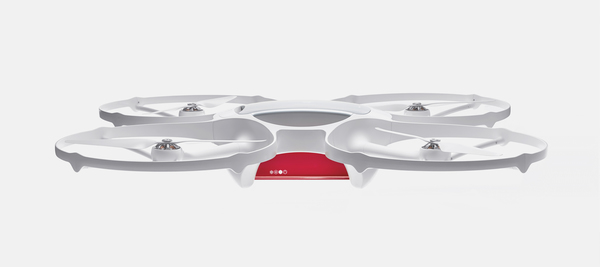Matternet launches drone delivery platform
I often speak about deliverbots -- the potential for ground based delivery robots. There is also excitement about drone (UAV/quadcopter) based delivery. We've seen many proposed projects, including Amazon prime Air and much debate. Many years ago I also was perhaps the first to propose that drones deliver a defibrillator anywhere and there are a few projects underway to do this.
Some of my students in the Singularity University Graduate Studies Program in 2011 really caught the bug, and their team project turned into Matternet -- a company with a focus in drone delivery in the parts of the world without reliable road infrastructure. Example applications including moving lightweight items like medicines and test samples between remote clinics and eventually much more.
 I'm pleased to say they just announced moving to a production phase called Matternet One. Feel free to check it out.
I'm pleased to say they just announced moving to a production phase called Matternet One. Feel free to check it out.
When it comes to ground robots and autonomous flying vehicles, there are a number of different trade-offs:
- Drones will be much faster, and have an easier time getting roughly to a location. It's a much easier problem to solve. No traffic, and travel mostly as the crow flies.
- Deliverbots will be able to handle much heavier and larger cargo, consuming a lot less energy in most cases. Though drones able to move 40kg are already out there.
- Regulations stand in the way of both vehicles, but current proposed FAA regulations would completely prohibit the drones, at least for now.
- Landing a drone in a random place is very hard. Some drone plans avoid that by lowering the cargo on a tether and releasing the tether.
- Driving to a doorway or even gate is not super easy either, though.
- Heavy drones falling on people or property are an issue that scares people, but they are also scared of robots on roads and sidewalks.
- Drones probably cost more but can do more deliveries per hour.
- Drones don't have good systems in place to avoid collisions with other drones. Deliverbots won't go that fast and so can stop quickly for obstacles seen with short range sensors.
- Deliverbots have to not hit cars or pedestrians. Really not hit them.
- Deliverbots might be subject to piracy (people stealing them) and drones may have people shoot at them.
- Drones may be noisy (this is yet to be seen) particularly if they have heavier cargo.
- Drones can go where their are no roads or paths. For ground robots, you need legs like the BigDog.
- Winds and rain will cause problems for drones. Deliverbots will be more robust against these, but may have trouble on snow and ice.
In the long run, I think we'll see drones for urgent, light cargo and deliverbots for the rest, along with real trucks for the few large and heavy things we need.








Comments
Steve H
Thu, 2015-04-02 05:05
Permalink
Killer problems
I think your comment about the potential for flying drones falling and injuring people will be a huge issue. Wind, trees, mischievous kids (and adults) throwing stones, dogs grabbing suspended payloads, it will be carnage. I am not optimistic that these problems will be that easy to solve. We will have to see what the results are when the first trials start but my guess is that drones travelling by road will have more success than their aerial cousins.
brad
Thu, 2015-04-02 10:21
Permalink
Drone problems
While Matternet plans to have special fenced off depots for landing of their drones, eliminating many of the problems, I think it is possible to deliver cargo to random places if the recipient is waiting there, able to signal the drone where to drop the cargo -- away from trees and wires and dogs and kids.
Winds will be a problem, drones will probably not deliver in gusty winds, though their automated systems may reach the level they can handle this.
Interference on route will remain a problem, though they will fly at 400 feet, which is a bit high for kids to throw rocks, but not too high for BB guns.
The big issue remains fear of falling if a drone is going overhead with heavy cargo. For Matternet they are working on path planning to find routes that minimize going over people's heads.
Russell
Thu, 2015-04-02 17:18
Permalink
Size of ground based deliverbots
I'm thinking that robo trucks will not only carry large items but large collections of items to supermarkets or local warehouses.
For some products like fresh food, footwear, online purchase may take some time before it is popular.
Many other products are better purchased in person due to the many limitations of online representations of the products.
The mix of sizes of vehicles will be fascinating to watch.
There is an obvious feedback effect as well, the more efficient/cheaper/flexible (esp convenient delivery time) the delivery service, the more appealing online purchase becomes.
If online purchase becomes ubiquitous, then there will be an interesting modelling task to determine the optimal frequency of local warehouses, and size distribution of vehicles.
Anonymous
Sun, 2015-04-05 04:48
Permalink
Landing in unknown terrain
Landing in unknown terrain would be more comfortable, when integration new BLE - Bluetooth beacon technology. so you can mark the landing area, reaching up to 70 meters and maternett one can navigate exactly to the point, measured in centimeters... no problem... i call this.. assisted landing... price of bluetooth device is about 7 USD...
brad
Sun, 2015-04-05 13:14
Permalink
BTLE
There is no need for low energy here! Cell phones and drones both have more than enough power for longer range wireless. But in fact, neither is the right answer. Pulsing light is much better and easy to make.
Add new comment